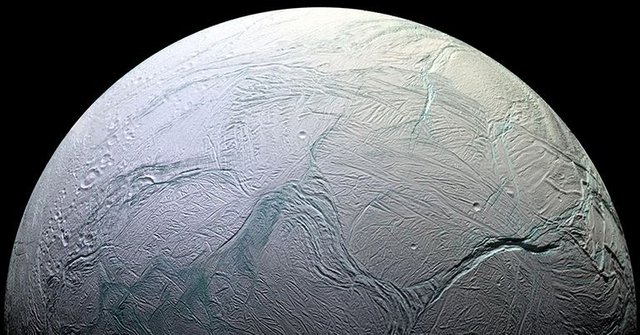Microbes found in Earth’s deep ocean might grow on Saturn’s moon Enceladus
Some very resilient Earth microbes might be able to thrive in the hidden ocean of Enceladus — the icy moon of Saturn that has become a prime candidate in the search for extraterrestrial life. Scientists have successfully cultivated a few of these tiny organisms in the lab under the same conditions that are thought to exist on the distant moon, opening up the possibility that life might be lurking under the world’s surface.
Enceladus is one of the most intriguing places in the Solar System since it has many crucial ingredients needed for life to thrive. For one, it has lots of water. NASA’s Cassini spacecraft — which explored the Saturn system from 2004 to 2017 — found that plumes of gas and particles erupt from the south pole of Enceladus, and these geysers stem from a global liquid water ocean underneath the moon’s crust. Scientists think that there may be hot vents in this ocean, too — cracks in the sea floor where heated rock mingles with the frigid waters. This mixing of hot and cold material seems to be creating a soup of chemical compounds that might support life.
Enceladus is one of the most intriguing places in the Solar System
In fact, some of the compounds that have been found in the plumes of Enceladus — methane, carbon dioxide, and hydrogen — are associated with a certain class of microbe that can survive without very much oxygen here on Earth. These organisms are known to gobble up carbon dioxide and hydrogen, and then release methane as a byproduct. So a group of researchers grew three kinds of these microbes in the same temperatures, pressures, and chemical solutions that are thought to exist on Enceladus. And one of the three strains was able to flourish and produce methane just fine under these conditions.
The research, detailed today in Nature Communications, is the first study to essentially recreate Enceladus in the lab. And it shows that life may have found a way to survive in an extremely cold and unfriendly environment deep within the Solar System. “It’s likely this organism could be living on other planetary bodies,” Simon Rittmann, a microbiologist at the University of Vienna and lead author of the study, tells The Verge. “And it could be really interesting to investigate in future missions.”
The types of microbes the researchers looked at are known as methanogenic archaea. Some types are found lingering here on Earth around deep-sea cracks known as hydrothermal vents, such as the Iheya Ridge near Japan. Researchers believe that our planet’s hydrothermal vents serve as a good analogue for the types of vents that may be within Enceladus. So similar microbes may have popped up near these deep-space fissures, too.
To test the microbes’ space survival skills, the researchers introduced the creatures to a wide range of scenarios that might be found on Enceladus. They estimated what the ratio of chemical compounds in the moon’s water would be based on Cassini’s data of the plumes, as well as the temperatures and pressures based on modeling. One of the species — Methanothermococcus okinawensis — fared the best under Enceladus conditions. And it even continued to thrive when the researchers introduced other unfriendly chemicals found on Enceladus, such as ammonia and carbon monoxide. These chemicals can actually curb the growth of the microbes — and yet, the hardiest of the three species was still able to reproduce when the compounds were introduced.
“This is stretching our conception of what’s possible.”
The researchers think that if the microbes are present on Enceladus, they could be lingering around the moon’s theorized vents — feasting on the hydrogen and carbon dioxide that these hot spots produce. And that may mean that the methane that has been detected on Saturn’s moon could actually be coming from these microbes when they excrete gas. “This is stretching our conception of what’s possible,” Christopher Glein, a geochemist at the Southwest Research Institute in San Antonio, who did not work on today’s study, tells The Verge.
While that idea is intriguing, this is just one scenario for how microscopic aliens could be living on Enceladus. Scientists still don’t know for sure that these organisms are even over there. And it’s possible that the methane stems from some other non-biological processes, such as from the hydrothermal vents themselves.
There is one way to figure out the puzzle of Enceladus: we have to go back. NASA’s Cassini spacecraft learned a lot from the moon, but it wasn’t designed to do a detailed analysis of the plumes on Enceladus. A future spacecraft could be equipped with tools that can finely measure the methane in the moon’s plumes, to figure out where the gas might be coming from. “We just can’t get these types of details unless we send a spacecraft that has really focused instrumentation,” says Glein.
It may be a while before we see that happen, though. NASA is focused on other planetary missions at the moment, such as one that will explore the potential plumes of Jupiter’s moon Europa. Those wanting to go back to Enceladus will have to compete with a number of other researchers who are proposing missions that will go elsewhere in the Solar System. But findings like those in today’s paper could raise the profile of Enceladus even higher — and make a return trip more likely.
“We know that life can exist there,” Jonathan Lunine, a planetary scientist at Cornell who worked on Cassini but did not contribute to this research, tells The Verge. “So there’s another reason to spend the resources to try to fly back to Enceladus and look for signs of life on the plume.”
Hi! I am a robot. I just upvoted you! I found similar content that readers might be interested in:
http://www.wlttyfeed.com/technology-and-science/microbes-found-in-earths-deep-ocean-might-grow-on-saturns-moon-enceladus/